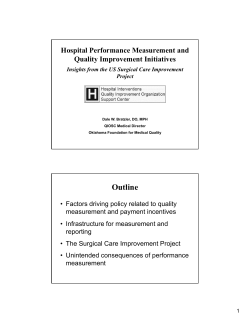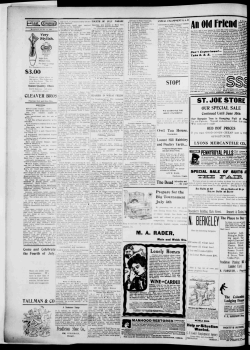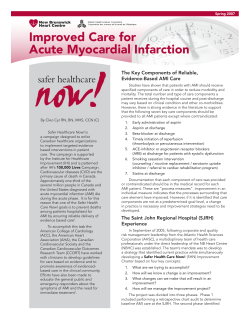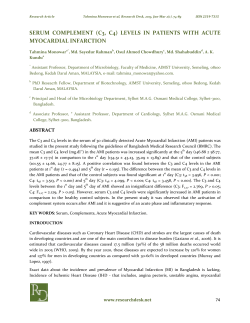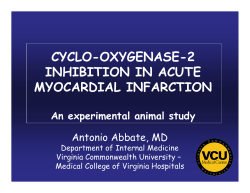
Core Measures Baptist Hospital of Southeast Texas
Core Measures Baptist Hospital of Southeast Texas Results for Southeast Texas Medical Associates, LLP (SETMA) Your Life Your Health The Examiner March 15, 2012 Data sharing has become an important part of healthcare delivery. Whether it is laboratory or procedure results, patient health information is increasingly being shared. The use of data to evaluate the quality of patient care is now getting the attention it deserves. Data has always existed but no one knew what it meant. It was “hidden” in paper which was “hidden” in medical records. It was time consuming and expensive to count records one at a time to determine the quality of care. The data could not be aggregated, analyzed or turned into information which could affect the direction or the quality of healthcare. Those days are gone. They went first with information which was looked at months after the healthcare was delivered. Healthcare companies laboriously review patient chars and count how many times patients had immunizations, or screening tests. Eventually, healthcare providers were given this information but in that it was 12 to 18 months after the event, they didn‟t care much. With the advent of electronic health records (EHR), data sharing has entered a new era. With EHR data can be aggregated quickly. Information that once took days and weeks to collect can now be collected in seconds. Data can be analyzed quickly and treatment strategies can be developed as quickly. The public reporting of quality data is increasingly becoming the standard for healthcare organizations and for healthcare providers. However, few organizations are publishing quality performance by provider name; SETMA began that in 2009. Ultimately, transparency at the provider level will become the national standard. A brief history of healthcare accreditation organizations in healthcare There are now dozens of organizations which offer one form of healthcare accreditation or another. The following are the oldest and perhaps principle ones: 1. The Joint Commission on Hospital Accreditation was founded in 1951 and had a significant change in focus in 1965 when it because the official organization for hospital accreditation. 2. The Accreditation Association for Ambulatory Care (1979) 3. Accreditation Commission for Health Care (1985) 4. Utilization Review Accreditation Commission (1990) 5. National Committee for Quality Assurance (1990) These organizations publish standards for quality performance and provide surveys and often site visits for organizational accreditation. The fact that most of these accreditation organizations have only existed for the past thirty years or so, lets you know how young healthcare quality assessment is. Healthcare Organizations which have voluntarily submitted to review by these accreditation bodies subject themselves to new standards of excellence. Hospitals do not voluntarily receive surveys; it is required. Eventually, the same will be required for all healthcare provider organizations (physicians, dentist, nurse practitioners and physician assistants) as well. SETMA has both AAAHC accreditation for ambulatory care and medical home, and NCQA recognition for medical home and diabetes care. There are about 250,000 groups of physicians in the United States and many more physicians who are in solo practice. Currently fewer than 3,000 groups have any form of accreditation or recognition for quality performance. Less than 1% of those publicly report quality performance by provider name. Public Reporting In that SETMA began pubic reporting on over 200 quality metrics by provider name in 2009, it was logical that when we were given our results on Hospital Cord Measures that we would publicly report those also. The following is an explanation of Core Measures and SETMA‟s results at Baptist Hospital of Southeast Texas for 2011. We hope soon to receive our results and to publicly report them from Christus St. Elizabeth and from the Medical Center of Southeast Texas. The Baptist Core Measures can be reviewed at www.setma.com under Public Reporting Core Measures. What are Core Measures? Hospitals across the country adhere to a set of care processes called Core Measures, which were developed by The Joint Commission, the nation's predominant standards-setting and accrediting body for inpatient health care, to improve the quality of health care by implementing a national, standardized performance measurement system. The Core Measures were derived largely from a set of quality indicators defined by the Centers for Medicare and Medicaid Services (CMS). They have been shown to reduce the risk of complications, prevent recurrences and otherwise treat the majority of patients who come to a hospital for treatment of a condition or illness. Core Measures help hospitals improve the quality of patient care by focusing on the actual results of care. Comparing Performance Hospitals across the country are measured and compared by The Joint Commission against all other accredited institutions on their performance in these Core Measures. You will note there is a time lag of several months between when data is reported from hospitals and when it is posted for the public to review. Hospitals have to wait for state and national statistics to be compiled before it can post its quality data for a given period. Hospitals report their results internally and more and more hospitals are beginning to share this data with the public. What does each of the Core Measures stand for? There are 33 Core Measures altogether, in 4 categories (acute myocardial infarction, communityacquired pneumonia, congestive heart failure, and surgical care improvement project). Under each category, key actions are listed that represent the most widely accepted, research-based care process for appropriate care in that category. It is important to note that these care recommendations are subject to the professional medical advice of each patient's physician and the particular health conditions of each patient. If a physician determines that a patient is not an appropriate candidate for a particular care process, the patient will not be included in the data. A good example is aspirin. Some patients are allergic to aspirin; for others, taking aspirin will make another medical problem worse. In these cases, the patient's physician may determine that aspirin should not be administered or prescribed for the patient. Therefore, the patients will not be included in the data. The following are technical descriptions of all of the core measures. Core Measures (Process of Care Measures) Accurate as of March 1, 2012 Measure Designation Measure Abbreviation Explanation Inpatient AMI measures speak to actions taken in the care of patients presenting with Acute Myocardial Infarction (AMI – commonly called “heart attack”) AMI 1 ASA on Arrival ASA =Aspirin. AMI 2 ASA on Discharge ASA = Aspirin. Patient is instructed to take aspirin daily at home following discharge. AMI 3 ACE/ARB for LVSD Patients who are diagnosed with left ventricular systolic dysfunction (LVSD – the heart, a pump, is not effectively pumping blood) are provided medications that improve the pump effectiveness. (These drugs are either classified as ACE inhibitors or an ARB). AMI 5 BB at discharge A beta-blocker (BB) is prescribed for the patient to take following discharge. Beta-blockers provide protection to the heart following an AMI. AMI 8a PCI w/in 90 minutes. Percutaneous Coronary Intervention (PCI) should be implemented (if the patient is a candidate) in less than 90 minutes. This involves the patient being taken to the cath lab for procedure. The PCI time is calculated from the time the patient enters the facility until the time when “the lesion is crossed” and blood flow is restored. AMI 10 Statin prescribed at discharge PC AMI Perfect Care AMI If the patient is on a Statin at home, the Statin must be prescribed at discharge unless there is a medical reason for the patient to not continue on the medication. AMI Patients received all applicable process measures. Measure Designation Measure Abbreviation Explanation HF=Heart Failure Sometimes referred to as “CHF” or Chronic Heart Failure HF 1 Discharge Instructions The patient receives specific instruction regarding five important elements of care that must be addressed following discharge. HF 2 LVF Assessment LVF = Left Ventricular Failure. There are a variety of ways for a physician to measure the function of the left ventricle. Assessment must be performed during the hospitalization, or test results performed prior to admission may be used as part of the evaluation. (Results must be present in the patient record during the patient stay.) HF 3 PC HF ACE/ARB for LVSD Perfect Care for Patients with Heart Failure IM=Immunizations IMM 1a Pneumococcal Immunization (overall) IMM 1b Pneumococcal Immunization (Age 65 and older) IMM 1c Pneumococcal Immunization, High Risk Population (Age 6-64) IMM 2 Influenza Immunization PC IMM Perfect Care r/t Immunization Recommendations Outpatient Treatment OP 4 Aspirin at Arrival – OP AMI OP 4c Aspirin at Arrival – Chest Pain PC OP CP Perfect Care for Outpatients with Chest Pain OP 6 Timing of Antibiotic Prophylaxis OP 7 PC OP Surgical OP 16 OP 19 Prophylactic Antibiotic Selection for Surgical Patients Perfect Care for Surgical Outpatients Troponin Results for ED AMI or ED CP Transition Record with Specified Elements Received by Discharged Patients See AMI 3 above. HF Patients received all applicable process measures. All patients who meet criteria are provided an opportunity to receive a Pneumococcal Vaccine prior to discharge. All patients who meet criteria (Age 65 or older) are provided an opportunity to receive a Pneumococcal Vaccine prior to discharge. All patients who meet criteria (Age 6-64 and determined to be high risk) are provided an opportunity to receive a Pneumococcal Vaccine prior to discharge. All patients who meet criteria are provided an opportunity to receive an Influenza Vaccine prior to discharge. All Patients who required immunizations received all applicable immunizations. All patients who meet the diagnosis of AMI receive Aspirin prior to transfer to a higher level of care. Outpatients with Chest Pain receive Aspirin on arrival to the ED prior to transfer to a higher level of care. All patients with a diagnosis of CP received all applicable process measures. Outpatient surgical patients who require prophylactic antibiotics, were provided an antibiotic within one hour of the surgical incision. Outpatient surgical patients received the appropriate antibiotic to prevent infection. All surgical outpatients received all applicable process measures. Troponin results were available for patients presenting with AMI or CP in time to insure appropriate treatment. Specific outpatients seen in the Ed received appropriate discharge instructions. Measure Designation PC OP ED Measure Abbreviation Perfect Care for the ED Outpatient Explanation Patient in the emergency department received all applicable process measures. PN measures are provided to patients with a diagnosis of pneumonia. PN 3a Blood Culture within 24 If a patient is admitted to ICU with a diagnosis of hours of arrival for Pneumonia, blood cultures are performed within 24 hours patients admitted to ICU of admission to the ICU. PN 3b Blood Culture in ER A blood culture (BC) should be drawn while the patient is before first antibiotic in the emergency room (ER) before any antibiotics (Abx) are provided to the patient PN 6 Appropriate ABX Antibiotic (Abx) selection should follow evidence based guidelines. PN 6a Appropriate ABX ICU Antibiotic (Abx) selection should follow evidence based Pneumonia patient guidelines. PN 6b Appropriate ABX NonAntibiotic (Abx) selection should follow evidence based ICU Pneumonia patient guidelines. PC PN Perfect Care of the Pneumonia patients received all applicable process Pneumonia Patient measures. SCIP = Surgical Care Improvement Project. The National Surgical Care Improvement committee has developed, in conjunction with the surgical and cardiac professional societies, best practice recommendations for the prevention of infection following a surgical procedure. SCIP Inf 1 Abx w/in 1 hour of surgery Prophylactic antibiotic (Abx) should be administered no more than one hour prior to the start of the surgery (defined as the „cut time‟). SCIP Inf 2 Abx Selection An appropriate antibiotic to prevent infection was administered. SCIP Inf 3 Abx d/c‟d w/in 24 hours of Antibiotic was stopped within 24 hours of the surgical surgery procedure. Continuing antibiotics has not been proven to be effective in preventing infection; however, overuse of antibiotics can lead to antibiotic resistance. Antibiotics may be continued up to 48 hours following certain cardiac procedures. SCIP Inf 4 BS control am day 1 & 2 cardiac SCIP Inf 6 Appropriate hair removal SCIP Inf 9 Removal of Urinary Catheter before 2nd Post-op Day Perioperative Temperature Management BB periop when on BB at home SCIP Inf 10 SCIP Card SCIP VTE 1 Appropriate VTE ordered Blood Sugar (BS) should be controlled following surgery as an elevated blood sugar may increase the risk for infection. Blood sugar is measured in the early morning the first and second day following cardiac surgeries to insure that it is in the appropriate range. Surgical site should not be shaved as shaving can leave microscopic cuts that increase the risk for infection. If hair needs to be removed, it should be clipped, not shaved. Urinary Catheter is removed by the end of the second day following surgery. Patients maintain the proper temperature in the operating room as recommended to prevent infection. If the patient is taking a beta-blocker medication at home, it is important that it not be stopped prior to surgery. The medication can be given with a „sip of water‟ prior to the scheduled procedure. VTE = Venous Thrombo Embolism (commonly called Measure Designation Measure Abbreviation Explanation „blood clot.‟) Chemical and mechanical measures have been defined that can prevent the formation of blood clots following surgery. This measure reflects that the physician has ordered treatment. To be effective, activities to prevent clots should be started within 24 hours of the surgical procedure. Most often, the measures are put into place prior to the operation, but some medications are not started until after surgery. If prophylaxis is not ordered (SCIP VTE 1) then the measures can not be implemented. SCIP VTE 2 VTE 24 hours before/24 hours after PC SCIP Perfect Care for the Surgical Patient Surgical patients received all applicable process measures. VTE Prophylaxis Patient receives appropriate chemical or mechanical measures to prevent clots or patient is up and walking without assistance by the second day. Discharged on recommended Antithrombotic medications. Stroke STK 1 STK 2 STK 6 Discharged on Antithrombotic Therapy Antithrombotic Therapy by end of Hospital Day 2 Discharged on Statin STK 8 Stroke Education STK 10 Assessed for Rehab PC STK Stroke Perfect Care STK 5 Antithrombotic medications are started in the hospital as recommended. Stroke patients are discharged on Statin medication as recommended. Education is provided to the Stroke patient that is appropriate to the diagnosis Stroke patients receive all necessary assessments to determine appropriate rehab treatment. Stroke patients received all applicable process measures. The following are SETMA‟s results for admission during 2011 at Baptist Hospital of Southeast Texas. The color coding lets you know whether or not SETMA meets the national benchmarks or not. Those in “green” meet or exceed the benchmarks. Those in “yellow” are a the low end of the benchmarks. And those in “pink or red” need improvement. The following Core Measures are for groups of metrics and represent the area in which SETMA will focus our attention the most in the coming year. The categories are Perfect Care for Acute Myocardial Infarction, Heart Failure, Pneumonia and Perfect Care for Surgical Care. SETMA performance for the following group of Core Measures is excellent. It will take time until we all, provider and patient, learn how to interpret and understand all of these measures. The fact that we have started the process is indicative of our commitment to excellence in healthcare.
© Copyright 2025





